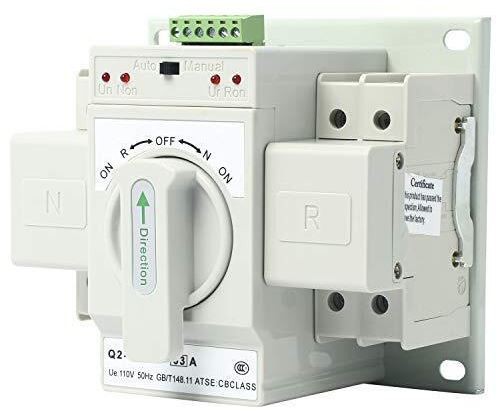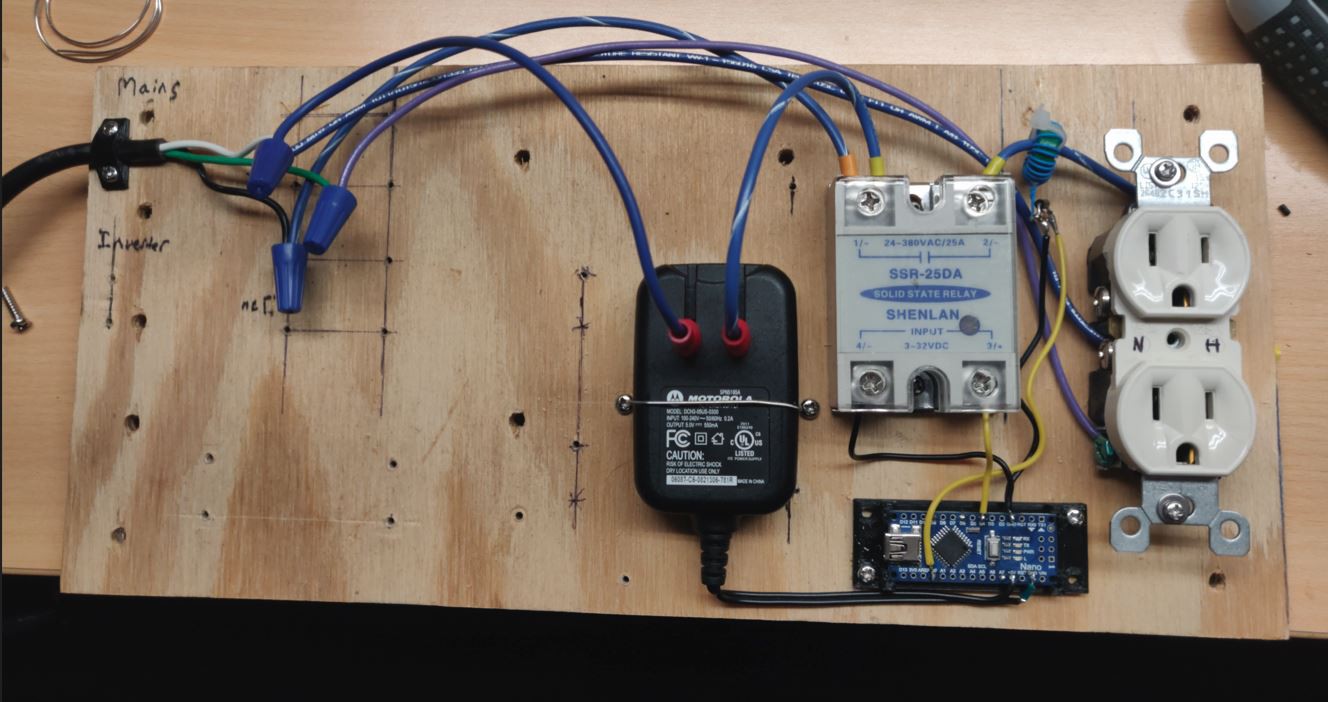I've made a lot of changes to the system since last post. Here's the system now:

New Automatic Transfer Switch:
First, I abandoned building my own automatic transfer switch. I decided I didn't want to worry about designing a part so safety critical. Instead I bought one off the shelf. It turns out they're not very expensive. This one was 28 USD on ebay. It doesn't seem to have a part number...

I wired it up so that the inverter is the primary source, and the mains is the backup. The system can now power the freezer as much as it's able, and if it runs out of juice the freezer will simply switch over to mains. At some point I would like to be able to set the voltage at which this happens, instead of relying on the cutoff of the BMS or inverter, but so far so good.
New Battery:
When I tested running the deep freezer on battery power, I found that it cut out with a lot of power still remaining in the lead acid battery. The inverter would be tripped off, and the battery would still be reading 12V.
I think what was happening is that due to age or just the battery type, it was sagging a lot under the 500W load that the deep freezer applies on startup.
I started looking for a second lead acid battery to both increase the capacity, and reduce the droop under load. However I was dismayed to see that not only were suitable batteries hard to come by, their price per kWh is now HIGHER than lithium-ion, despite being worse in every single way.
Rather than throw good money after bad, I decided to ditch the lead acids all together and switch to lithium ion.
I bought a box of 100 new and high quality Samsung (INR18650-33G) cells from BatteryHookup for 201 USD.
Combined, they have 1134wh of energy, and 321A max discharge current at 12V.
My original lead acid by comparison is only 720wh new. Is rated for 330A (which it certainly could not do for any length of time while maintaining its output voltage), and it costs 345USD new from mouser, maybe as low as 250 if I shopped around. In short its lower capacity, heavier, and more expensive.
Now, the catch is that I had to assemble the cells into a pack. I'm not going to lie this was pretty time consuming, since I made the pack totally custom. However in the future I think I'll be able to bang out a pack in 3 or 4 hours.

I decided to go 3S33P. To make it a 12V pack. That's not ideal, because it means a LOT of current is required to get hundreds of watts out of it. However a 12V battery will be compatible with a much larger variety of gear. So basically I went with versatility over efficiency.

Here's the completed pack with a Daly 3S BMS installed. It has a current limit of 30A continuous 60A burst. This is far less than the batteries are capable of, but its intentional. The interconnects have to withstand that current as well, and designing them to handle 300A would have been prohibitively complicated and expensive. The BMS was 30USD shipped.
I could write a whole blog post about this battery but honestly it's been done a thousand times so what's the point.
There is one feature that I would like to call attention to, because I think it's often overlooked. Noticed that I wired the balance plug in such a way that it can be disconnected from the BMS. This is important.
When you store a lipo battery unused for many years, the BMS can greatly accelerate the self discharge of the battery, eventually leading to damaged cells. I have found that with no BMS, and at a storage charge of 3.75V per cell, lipos age extremely well. I have lipos that have been stored this way for 10 years without maintenance, and they seems as good as new when I put them to use. Try that with some "protected" powertool battery... Therefore, it was important to me that if I ever take this battery out of service, I should be able to store it the same way.
The connector on the battery is an XT90 (rated for 90A). I use XT60s on my drones and I've found them to be very reliable, easy to connect/disconnect, and not prone to coming apart on their own.
New Charge Controller:
During a sunny day, my 200W solar panels were maxing out my 10A MPPT charge controller, so I swapped that out for the 40A version (Tracer 4210AN). Bought used on ebay for 91USD shipped.
Freezer Overcurrent Timeout:
If the freezer is powered down while the compressor is running, and then shortly powered back up, the compressor will run backwards, drawing 500W or more for a long time. You can't hear it, and it seems to recover on its own eventually, but I believe just letting it happen would stress the solar system unduly. So far I haven't witnessed the automatic transfer switch cause this condition, but theoretically it could.
I tried using an AC current transformer to detect the condition with an arduino, and found that it can easily be detected. So I created this goofy arrangement.

If it detects a large current for greater than 3 seconds, it "trips" and shuts off the output for 5 minutes. I tested it by intentionally plugging and unplugging the freezer and it does work.
It records the number of trips so I can see later that it happened. Interestingly, I haven't seen it trip with the new battery. I think the lead acid battery browning out the inverter was wreaking all sorts of havoc with the system. But regardless, the system can explicitly handle the compressor-running-backwards condition.
I can post more details about this device if people are interested.
 Drew Pilcher
Drew Pilcher
Discussions
Become a Hackaday.io Member
Create an account to leave a comment. Already have an account? Log In.